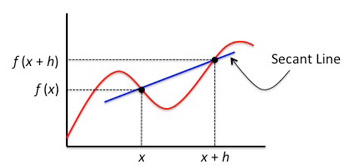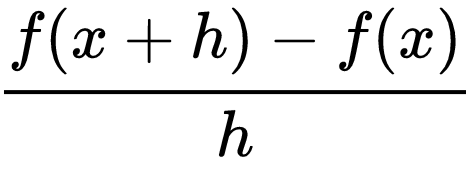The difference quotient is a way to find the derivative or a slope of a function. Firstly, the difference quotient measures the function’s average rate of change over a period (h). As a result, the instantaneous speed of change is the difference quotient’s limit (i.e., the derivative).
However, in simple language, the difference quotient is a formula in calculus, we use this formula to calculate the derivative. The difference quotient between two points that are as close together as feasible and indicates the rate of change of a function at a single point. Isaac Newton invented and formulated the concept “difference quotient.”
Calculation of the Difference Quotient:
This formula determines the slope of the line through two points on the graph of f.c. Eventually, these are the x-coordinate points x and (x + h). We define the derivative using the difference quotient. First, put (x + h) anywhere you see an x into your function. Once you’ve determined f (x + h), put your numbers into the difference quotient formula and simplify from there. So, the use of the subtraction sign in the third step removes the parentheses and simplifies the difference quotient.

On the other hand, you’ll see in the formal definition of the difference quotient that the slope we’re calculating is for the secant line. However, a secant line is simply any line that connects two points on a curve. On our x-axis, we label these two locations as x and (x +h). Because we are working with a function, we mark these points on our y-axis as f (x) and f (x + h), respectively.
However, In simple terms, the difference quotient helps us find the slope when working with a curve. In the case of a turn, we cannot use the traditional formula. Which is why we must use the difference quotient formula.

The formula for the Difference Quotient:
The following are the steps we use to determine the difference quotient:

1) Put (x + h) into the function f and simplify to get f(x + h).
2) Now that you’ve calculated f(x + h), calculate f(x + h) – f(x) by putting in f(x+h) and f(x) and simplifying.
3) Put in your step 2 result in the numerator in the difference quotient and simplify it.
As we take it to the limit, h approaches zero and returns the derivative of the function f. The expression gets its name because it is the quotient of the function’s difference in values by the difference in the corresponding values of its input [in this example, (x+h)-x =h].
Quotients of Symmetric Difference:
In mathematics, the difference quotient is a formula that gives an estimate of a function’s derivative. Moreover, there are two types of difference quotient: one-sided difference quotient and symmetric difference quotient. They are all connected, and one provides a better approximation than the others because of this connection.
In mathematics, the symmetric derivative is a mathematical procedure that generalizes the ordinary product. We can define it as follows:
However, the equation below the limit is also known as the symmetric difference quotient. If a function’s symmetric derivative exists at point x, it can be symmetrically differentiable at that point.
If a function is differentiable (in the normal sense) at a point, it is also symmetrically differentiable, but not vice versa. The absolute value function f(x) = |x|, which is not differentiable at x = 0, but is symmetrically differentiable here with symmetric derivative 0, is a well-known counterexample. The symmetric difference quotient provides a better numerical derivative estimate than the standard difference quotient for differentiable functions.
If the left and the right derivatives exist at a given location, the symmetric result is the arithmetic mean of the latter two.
Rolle’s theorem nor the mean value theorem applies to the symmetric derivative; however, we demonstrate several similar but weaker assertions.
The modulus function:
The modulus function graph. Take note of the sharp bend at x=0, which results in the curve being non-differentiable at x=0. As a result, the function has no ordinary derivative at x=0. However, the symmetric product exists for the position at x=0.
At x=0, we have the modulus function, f(x)=|x|.
Since h>0, we have |h|=-(-h). As a result, we can see that the modulus function’s symmetric derivative exists and is equal to zero at x=0, even though its conventional derivative does not exist at that point (owing to a “sharp” turn in the curve at x=0).
NOTE both the left and right derivatives at 0 exist in this case, but they are unequal (one is -1 and the other is 1); their average is 0, as predicted.
Difference Quotient Example:
The difference quotient for the function f(x)=3-x2-x is as follows:

The difference quotient for the function is:

The difference quotient for the function q(z) = -14 is as follows:

How do you calculate the quotient?
To calculate the quotient, divide the dividend by the whole-number divisor. To make the divisor a total number, multiply it by a power of ten. Divide the dividend by the same power of ten. Insert the decimal point into the quotient. To calculate the quotient, divide the dividend by the whole-number divisor.
What is SA’s derivative?
A derivative is a contract between two or more parties. We determine the value by an agreed-upon underlying financial asset (such as security) or group of assets (like an index). Bonds, commodities, currencies, interest rates, market indexes, and stocks are standard underlying instruments.
What exactly is a quotient example?
The outcome of dividing one number by another, divisor dividend = quotient. For instance, in 15/ 3 = 5, 5 is the quotient division.
What is the Quotient formula?
The quotient rule is a formula for calculating the derivative of a quotient of two functions. Suppose the function f(x) is in the numerator and the function g(x) is in the denominator. In that case, we calculate the derivative using the following formula: The d in this formula represents a derivative.
What exactly is a quotient function?
The quotient function returns the integer part of a division. As easy as that. There are two arguments: the numerator is the dividend, and the denominator is the divisor. Because the integer component of 4.5 is 4, the Quotient function returns 4.





